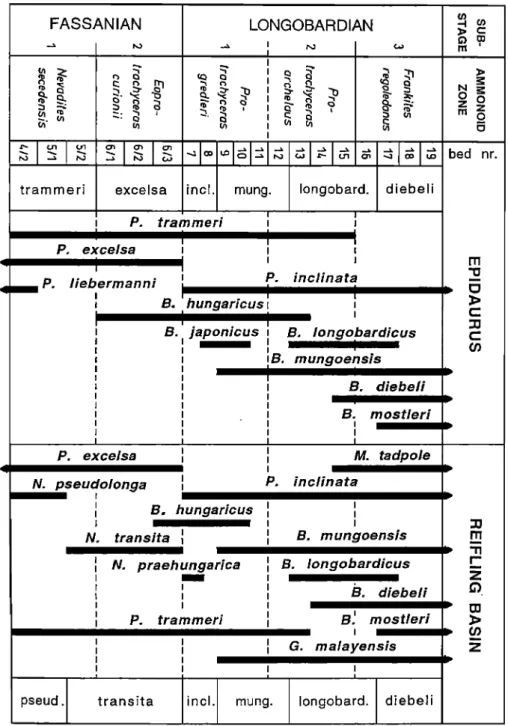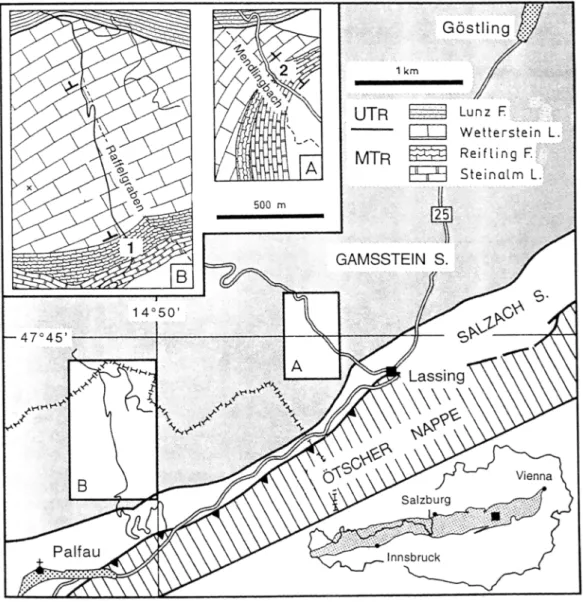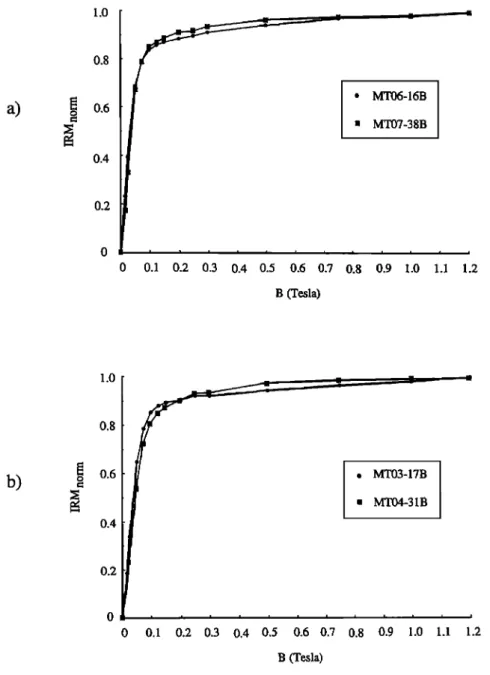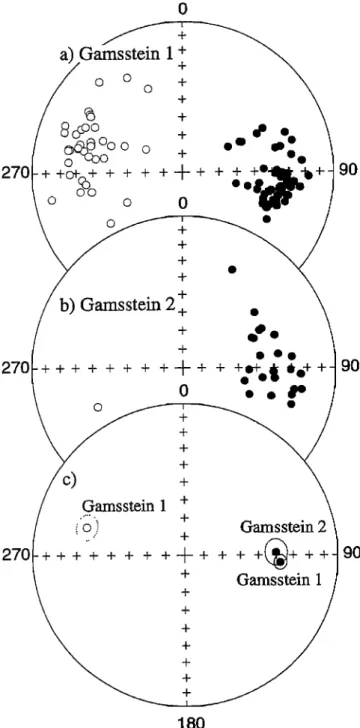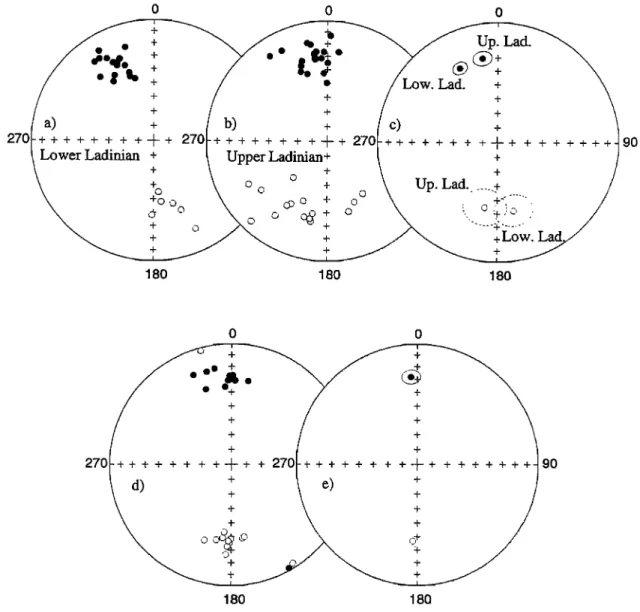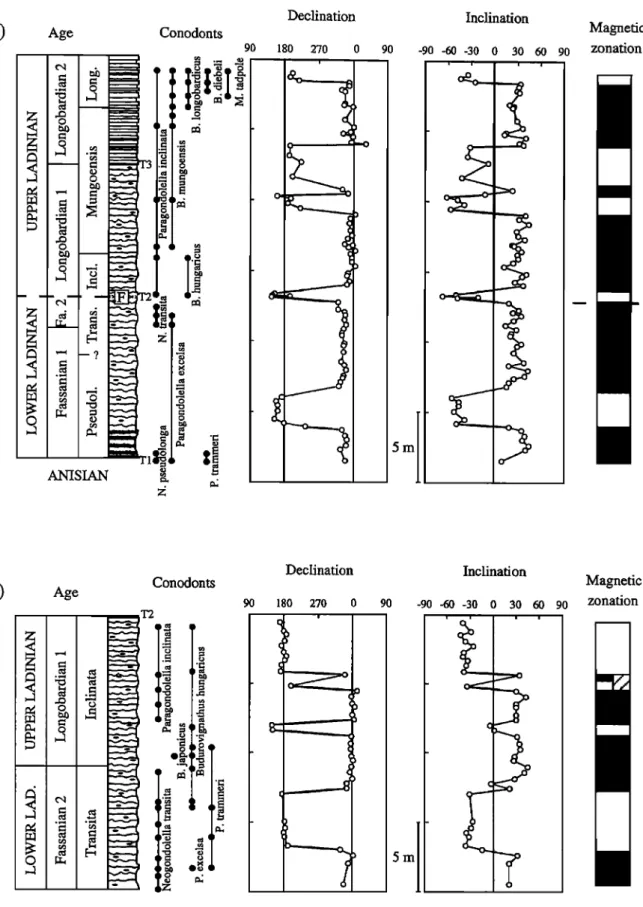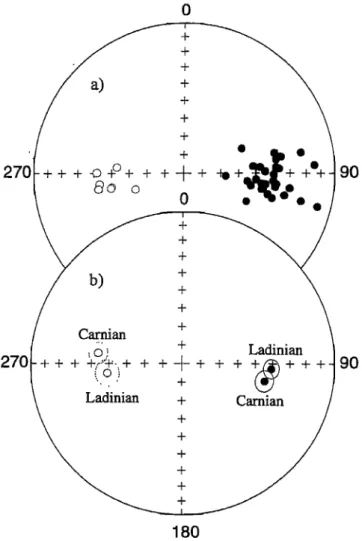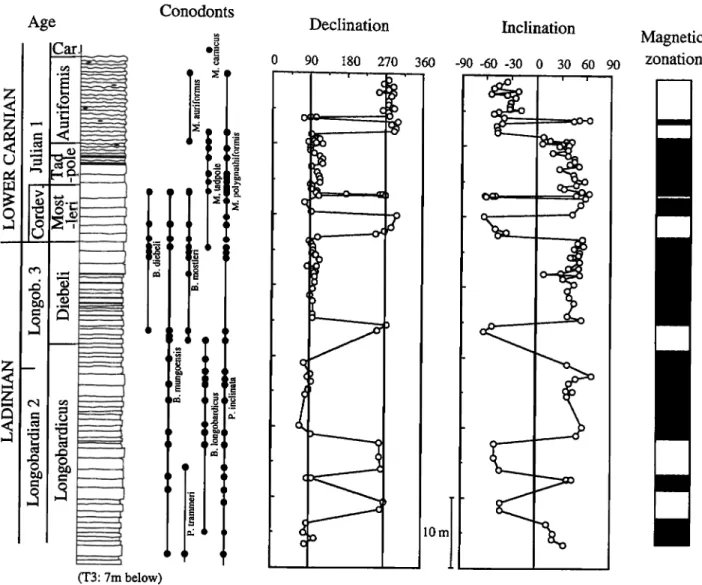HAL Id: insu-01863517
https://hal-insu.archives-ouvertes.fr/insu-01863517
Submitted on 28 Aug 2018
HAL is a multi-disciplinary open access
archive for the deposit and dissemination of
sci-entific research documents, whether they are
pub-lished or not. The documents may come from
teaching and research institutions in France or
abroad, or from public or private research centers.
L’archive ouverte pluridisciplinaire HAL, est
destinée au dépôt et à la diffusion de documents
scientifiques de niveau recherche, publiés ou non,
émanant des établissements d’enseignement et de
recherche français ou étrangers, des laboratoires
publics ou privés.
Upper Anisian to Lower Carnian magnetostratigraphy
from the Northern Calcareous Alps (Austria)
Yves Gallet, Leopold Krystyn, Jean Besse
To cite this version:
Yves Gallet, Leopold Krystyn, Jean Besse. Upper Anisian to Lower Carnian magnetostratigraphy from
the Northern Calcareous Alps (Austria). Journal of Geophysical Research : Solid Earth, American
Geophysical Union, 1998, 103 (B1), pp.605-621. �insu-01863517�
JOURNAL OF GEOPHYSiC• RESEARCH, VOL 103, NO. B1, PAGES 605-621, JANUARY 10, 1998
Upper Anisian to Lower Carnian magnetostratigraphy
from the Northern Calcareous
Alps (Austria)
Yves Gallet
Laboratoire de Pa16omagn6tisme, URA 729, Institut de Physique du Globe de Paris, France
Leopold
Krystyn
Institute for Paleontology, Vienna, Austria
Jean Besse
Laboratoire de Pa16omagn6tisme, URA 729, Institut de Physique du Globe de Paris, France
Abstract. We present
a magnetostratigraphic
study
of three
pelagic
limestone
sections
(Gamsstein, Mendlingbach and Mayerling) from the eastern part of the Northern CalcareousAlps.
Together
these
sections,
which contain
a rich conodont
fauna,
yield a sedimentary
record
encompassing
the uppermost
Anisian,
the Ladinian
and the Lower Carnian.
Thermal
demagnetization and isothermal remanent magnetization experiments indicate that the
magnetization
is essentially
carried
by a mineral
of the magnetite
family. The high
unblocking temperature components isolated from the three sections provide clear magnetic
polarity
zonations.
Correlations
between
these
results,
based
on the biostratigraphic
data
and
tephrochronology,
allow the construction
of a composite
magnetic
polarity
sequence
from the
Illyrian substage (Upper Anisian) to the Julian 2 zone (Lower Carnian). This sequence contains 17 well-defined polarity reversals, and eight more poorly defined intervals. Correlations can be suggested between the new data and other magnetostratigraphic results previously obtained from marine sections. We estimate that the magnetic reversal frequency was 2.5 to 3.6 reversals per million years during the Ladinian.Introduction
The Triassic magnetostratigraphy has been recently improved by several studies both on marine and continental
sedimentary sections [e.g., Steiner et aI., 1989; Ogg and
Steiner, 1991; Gallet et aI., 1992, 1993a, 1994, 1996; Muttoni and Kent, 1994; Muttoni et al., 1994, 1995, 1996, 1997; Kent et al., 1995; Molina-Garza et al., 1991, !993,
1996]. However, these data concentrate on the magnetic reversal chronology during the Late and Early Triassic. For the Middle Triassic, magnetostratigraphic results obtained from marine sediments are available only for the Lower and Middle Anisian [Muttoni et al., 1995, 1996] and from the Uppermost Anisian to the Lower Ladinian [Muttoni and Kent,
!994; Muttoni et al., 1994]. Other studies that provide
information about Middle Triassic magnetostratigraphy come from the southwestern United States (upper Moenkopi formation [e.g., Helsley and Steiner, 1974; Baag and Helsley, 1974; Elston and Purucker, 1979; Lienert and Helsley, 1980; Purucker et al., 1980; Molina-Garza et al., 1991, 1996]) and from Spain [Turner et al., 1989]. These data were obtained from continental sediments (red beds) where biostratigraphic control is generally poor. And because the construction of a
Copyright 1998 by the American Geophysical Union.
Paper number 97JB02155.
0!48.0227/98/97JB.02155509.00
reliable composite magnetic polarity sequence from these latter results is problematic, they should be constrained by additional magnetostratigraphic data from well-dated marine
sections.
In this study we report the magnetostratigraphy of three pelagic limestone sections from the Northern Calcareous Alps
(NCA; Austria). Correlations between these sections based on
conodonts and taphrostratigraphy allow the construction of a magnetic polarity sequence from the Uppermost Anisian to
the Lower Carnian.
Ladinian Biochronology and Chronostratigraphy
Several recent studies that focused on the Ladinian
biochronology [e.g., Brack and Rieber, 1993, !994; Kovacs et al., 1994; Mietto and Manfrin, 1995] show differences
both in the content and scope of the recognized
biostratigraphic zones. Consequently, the Ladinian may
either contain six ammonoid zones (with the inclusion of the
Reitzi zone [Kozur, !995]), five zones (beginning with the Nevadites zone [Krystyn, 1983]) or four zones (beginning with the Curionii zone [Brack and Rieber, 1994; Bucher and
Orchard, 1995]). In this study we will use the second variant
which corresponds to possibility B suggested by Brack and Rieber (1994). In this way, the base of the Ladinian is marked by the onset of the Nevadites secedensis zone and approximates closely to the appearance of the conodont
606 GALLET ET AL.: MAGNETOSTRATIGRAPHY FROM NORTHERN CALCAREOUS ALPS
Paragondolella tram/neri [see Krystytz, 1983; Nicora and Brack, 1995; Muttoni et al., 1997]. The Lower Ladinian
contains two ammonoid zones (the Fassanian 1 and 2 zones)
and the Upper Ladinian three zones (the Longobardian 1 to 3
zones).
The three Ladinian sections analyzed in this study come
from the Reifling formation which is apparently devoid of
ammonoids but contains rich conodont faunas. The latter have
been grouped into six intervals and have been chronostratigraphically fixed by conodont-based correlations
with the ammonoid-rich sections of Epidaurus (Greece) and
Bagolino (Northern Italy). However, the chronostratigraphy of the Epidaurus section needs to be reconsidered because
additional ammonoid and conodont faunal data collected in
1994 provided new stratigraphic constraints (Figure 1) [Krystyn, 1983]. The ammonoid zonation is nomina!y
modified by introducing the Secedensis zone, and also stratigraphically by shifting beds 10 and 11 from the Archelaus zone downwards to the Gredleri zone (Figure 1). The reason for this revision is the discovery of a Protrachyceras gredleri specimen in bed 10. Bed 11 lacks diagnostic
ammonoids but it has identical lithology and microfacies as
the underlying levels 10 and 9. The other changes in conodont faunas concern Paragondolella excelsa (Last Occurrence Datum [LOD] in bed 6/3), P. inclinata (First
Occurrence Datum [FOD] in bed 7), the introduction of
Budurovignathus longobardicus from beds 13 to 17 and the removal of Gondolalla cf bakalovi (see comment of Kovacs [1994]). Within the Upper Fassanian, the former Hungatica zone has been renamed for P. excelsa in order to avoid any further confusion with the original scope of this zone [Kozur,
•980].
FASSANIAN
LONGOBARDIAN
• •
! ß • , • • • , •" z z •' • ' • • i • m o II I
I i
...
I
...
III
I I
1"1
• • • ½ • • m m • • % • • • • • • g • bed hr. • ., ,tramtoefl excelsa incl. mung. Iongobard. diebell
...
•
P, trammeri
•
i I P, excelsa • •P. Iiebermanni
•
P. inclinata
--
.•
B. /apontcus
• B, Iongobardicus
I i i • • •B. mungoensis I I ' II IIIIi III II II I I I I • • • B. diebeli I I ! • • • B. mostleri I I i ! ... I ,, I ... I ,, ! .......
t=dp
P. excelsa • ! • I M. ole • P. inclinata N. pseudoionga I ! i • B. hungaricus • • B. m ungoensis mN. transira •
• N. praehungarica • B. Iongobardicus
I • I • • Z•
•
•
B. diebell
i i i i P, trammeri i mostlerii
!
i G. malayensis
I I I I I I I I I IIIIIII II I I ! I I ß ,,,,i ... I ,,, i ...pseud, transita incl. mung. Iongobard. diebeli
...
GALLlET ET AL.: MAGNETOSTRaTIGRAPHY FROM NORTHERN CALCAREOUS ALPS 607
Many sections of the Reifiing basin contain three distinct tuffaceous layers with a light grey to greenish primary and
.,,ellowish
weathering
secondary
color.
These
layers
probably
represent
altered
pietra
verde.
They have
been
numbered
as T1,
T2 and T3 in our sections and are interpreted as geologicallyisochronous and therefore chronostratigraphic marker beds.
Tephrochronology thus provides an independent tool to
constrain the adopted correlations based on conodonts and to establish long-distance time relationships with other tuff-
bearing Ladinian sections of the Alpine region. In particular,
Kozttr and Mostlet' [1971] described a section from the
Nemesvamos formation (Koeveskal, Balaton Highland, Hungary) with two distinct tuffaceous intervals at 7.5 and 11.5
m which may correspond to the T2 and T3 layers of the
Reifling basin according to the conodont data. The T2 and T3 layers may be also identifiable in Reifiing limestones from the
Western Calcareous Alps (e.g., from the Martinswand section
from Tyrol [Bechsttidt and Mostlet', 1974]). Tephrochronologic correlations with the Buchenstein basin of
northern Italy are more difficult because of the large number of tuffaceous layers in this basin. However, grouped on the basis
of local frequency peaks, the Buchenstein sequence also shows
three major tuffaceous intervals which are located in the well- known Bagolino section at 61 m, between 70 and 75 m and 84-
88 m, respectively [Bracl, et al., 1995]. According to Nicora
and Brack [1995], these intervals fit closely in age •ith the three Reifling basin layers.
Geological Setting, Lithology and Sampling
The studied sections are located in the eastern part of the Northern Calcareous Alps, within the so-called Bajuvaricum mega-unit. This unit consists of a series of north vergent
nappes stacked between the Cretaceous and the early Cenozoic
[e.g., Tollmann, 1976]. Two of the sampling sites, the Mendlingbach and Gamsstein sections, are situated in a local tectonic structure, the "Reifiinger Scholle", intercalated between the Lunz nappe to the north and the Oetscher nappe to the south. This structure, which has a maximum length of approximately 10 km between the village of G6stling and the Enns valley (Figure 2), is itself divided into smaller units called "Schuppen" of which the Gamsstein-Schuppe includes
500 m 47ø45 14050 ' II ß ?.:'-....' ::-
UTR ••
Lunz
E- ..::::•:
...
::.:
....
,...:).
: " L_LJ Wetterstein L..':';' ßMTR •
Reifting
E":
......
'"'?.
•
Steinaim L. •
:..'
GAMSSTEIN S. Lassing Salzburg Vienna Palfau _. InnsbruckFigure 2. Location
map of the Gainsstain
(B) and Mendlingbach
(A) sections
and simplified
geologic
608 GALLET ET AL.' MAGNETOSTRATIGRAPHY FROM NORTHERN CALCAREOUS ALPS
w
• Ze
•
I,
uJ
GALLET ET AL.: MAGNETOSTRATIGRAPHY FROM NORTHERN CALCAREOUS ALPS 609 1.0
0.6
0.4 0.2 0 0 0.1 0.2 0.3 0.4 0.5 0.6 0.7 0.8 0.9 1.0 1.1 1.2 B (Tesla)b)
1.0 0.8O.6
0.4 0.2 0 0 0.! 0.2 0.3 0.4 0.5 0.6 0.7 0.8 0.9 1.0 1.I 1.2 B (Tesla)Figure 4. IRM analyses of samples from the (a) Gamsstein and (b) Mendlingbach sections. In both sections the saturation is almost achieved in a 0.3 T field which likely indicates a magnetization dominated by a mineral in the magnetite family. A small fraction of a high-coercivity mineral is also observed.
the two sections (Figure 2). The third section (Mayerling) is located about 100 km to the east of the other two sections,
approximately 30 km southwest of Vienna (see Gal!et et al.,
1994,
Figure 1]. A previous
study
of this section
provided
a
Lower Camian magnetostratigraphic sequence [Gallet et al.,19941.
Ladinian strata crop out widely within the NCA. They can be broadly grouped in two main sedimentary environments: (1)
large
shallow-water
carbonate
platforms
of the Wetterstein
formation
and (2) deeper
basins
filled with hemipelagic
limestones
of the Reifling formation.
The latter usually
consists of dark grey, chert-rich, thin-bedded filament andradiolarian-bearing
wackestones.
Although
belonging
to the
Reifling formation, our sections show some facial differences as they are composed of light colored (grey to yellowish) limestones of various thicknesses with less chert. Themicrofauna
is also more
diverse,
containing
foraminifera
and
relatively abundant conodonts. The intercalations of redeposited shallow-water debris in Mayerling and the close
proximity of platform carbonates
in Gamsstein and
Mendlingbach suggest a specific oceanographic environmentfor these sections.
Gamsstein Section
This section is located about 1 km northeast of the village
of Palfau, and approximately 2 km southwest of Mendlingbach (Figure 2, site B). The section outcrops at an altitude of !010 m, along a forest road leading from the Bundesstrasse 25 to the Gamsstein plateau, at the western side of the deeply incised Raftel grabben. The section was divided into two subsections
about 25 m from each other. The first site (Gamsstein 1)
consists of 27 m of Upper Ladinian sediments from which we collected 88 palcomagnetic samples. Twenty five samples
610 GALLET ET AL.: MAGNETOSTRATIGRAPHY FROM NORTHERN CALCAREOUS ALPS o
a)
Gamsstein
: .-'::
1
270[++•+
+ + + +++
+ +
o 0
270 90 270 90 180Figure 5. Equal-area projection of directions of the high-
unblocking temperature component obtained from the (a)
Gainsstein 1 and (b) Gamsstein 2 subsections. Solid (open) symbols refer to directions in the lower (upper) hemisphere. (c) The mean normal and reversed polarity directions.
were drilled from the second (Gamsstein 2), which is stratigraphically thinner (5 m) with an age ranging from the Upper Anisian to the Lowermost Ladinian. Approximately 50 conodont samples were obtained from these two subsections.
Mendlingbach Sections
Two sections were sampled near the small village of Lassing (Figure 2). The first, called Mendlingbach-East, is exposed along a road at the eastern side of a valley, about 1 km north of Lassing. It has a thickness of about 30 m. The second, called Mendlingbach-West section, is located along the western side
of the same valley where a forest road was recently built. This latter section is important because it includes a 13-m-thick
interval
that is missing
in Mendlingbach-West
due
to faulting.
Fifty five conodont samples were collected from the whole sequence, and the related data indicate an age from the Lower to the Upper Ladinian. Over 100 paleomagnetic samples weredrilled in the Mendlingbach-East section and 40 in the Mendlingbach-West section.
Mayerling Section
This section is exposed along a railway cutting, 1 km northwest of the village of Weissenbach (see Gallet et al.,
1994, Figure 1 ]. A new stratigraphic interval of approximately 40 m was sampled. This sequence differs lithologically from typical Reifling limestones because of thicker bedding, lack of
chert bands, and by the presence of stromatactis-!ike calcite
cavities up to 5 cm in length and 2 cm in height. Twentwfive
conodont samples provided a faunal record from the
Longobardian 2 to the Longobardian 3 zones (Upper Ladinian). Forty samples were collected for paleomagnetic
analysis.
Chronostratigraphy and Biostratigraphy
of the Reifling Sections
The Upper Anisian (Illyrian substage) is very thin in the
investigated sections (approximately 1.5 m) and starts with a
distinct erosional surface. Accumulations of cephalopod shell fragments and the microfacies (echinoderm and glauconite
bearing packstones) indicate bottom current activity with possible erosion and/or nondeposition of sediments. The upper half of this stratigraphic interval is dated by
ammonoids. Aplococeras ? sp., "Ceratites" cf. lenis, Parakellnerites rothpIetzi, P. zonianensis, Hungarites ? cf.
plicatus, Flexoptychites acutus, F. noricus, F. gibbus and Ptychites arthaberi were found in Gamsstein (bed M1). Following Brack and Rieber [1994], this fauna clearly
characterizes the Reitzi zone and is probably located close to
the base of the Nevadites recte Secedensis zone sensu Brack
and Rieber [1994]. The rich conodont fauna of M1 includes Neogondolella constricta./cornuta, Paragondolella liebermanni and P. excelsa. The FOD of N. pseudoIonga is located three
beds above M1 (about 60 cm), less than 10 cm below the
tuffaceous layer T1. For practical reason, the Anisian-Ladinian boundary is drawn here at the base of T1, 20 cm below the FOD of P. trammeri. Following Nicora and Brack [1995] who have found N. transira from the Chiesense level (top of the Secedensis zone) of Bagolino, the Fassanian 1 to 2 boundary has to be placed within the Transita zone (Figure 1).
The boundary between the Lower and Upper Ladinian
coincides with the FOD of P. inclinata as documented from
ammonoid-dated rocks from 'Epidaurus. Within the Upper
Ladinian,
no corresponding
boundaries
between
ammonoid
and
conodont zones could be established. The adopted
Longobardian
1/2 boundary
results
from a tephrochronologic
correlation of the Reifling T3 layer with the 84-88 m tuffaceous interval of the Bagolino section. The latter horizon
is included
into the lower
Longobardian
2 zone
on the
basis
of
ammonoids and daonellids by Bracket al. [1995]. Conodonts support the above postulated correlation because
Budurovignathus
mungoensis
is observed
in these
tuffaceous
GAt J•ET ET AL.: MAGNETOSTRATIGRAPHY FROM NORTHERN CALCAREOUS ALPS 611
levels from both sections. The boundary between Longobardian 2 and 3 cannot be well constrained by conodonts and it might be located somewhere in the upper part of the Longobardicus zone. Finally, the Ladinian/Carnian boundary is datable by the FOD of Paragondolella polygnathiformis, a datum already used in our earlier
magnetostratigraphic studies [Gallet et al., 1993a, 1994].
The ranges of platform conodont species in the Gamsstein, Mendlingbach and Mayerling sections are shown in Figure !. N. pseudolonga, N. transita, P. excelsa, P. trammeri and Gladigondolella tethydis are the most abundant species found in the Lower Ladinian, and P. inclinata, B. mungoensis and G. malayensis are the most abundant species found in the Upper Ladinian. We paid special attention to the fact that some stratigraphic guide forms have more limited ranges in the Reifiing intraplatform basin than in the eupelagic to miopelagic settings of Epidaurus or of the Balaton region [Kovacs, 1994]. Indeed, some species common in the Reifling basin (e.g., N. pseudolonga, N. transita and Metapolygnathus tadpole) are missing in Epidaurus. Some others (N. praehungarica, P. trammeri and B. hungaricus) have more limited ranges in the Reifiing limestones. Therefore the detailed vertical distribution of all species has been primarily established and used for correlation of the sections sampled for
magnetostratigraphy. Future studies may decide on its applicability as a local reference scale for Ladinian
intraplatform basins of the Alpine region.
The discriminated zones are all defined by the FOD of their nominate species except for the Diebeli zone. In our sections, N. pseudolonga replaces N. cornuta or N. constricta cornuta sensu Kovacs [1994] in the bed just below T1. P. trammeri used by Krystyn [1983] as a marker for defining the base of the Ladinian in the pelagic facies, appears directly below T1 in the Mendlingbach-East section and slightly higher (0.2 m) in the Gamsstein section with rare juvenile individuals but becomes common above. P. excelsa and G. tethydis range throughout the Pseudolonga zone. The sudden increase in frequency of the latter species could be used as an additional lower zonal boundary indicator. N. transita which may be a synonym of N. excentrica (see also comments by Kovacs [1994]) occurs together with G. tethydis, P. excelsa and P. trammeri
throughout the Transita zone. B. hungaricus appears with rare
specimens in the upper half of this zone. Within the !nclinata
zone, P. inc!inata, G. tethydis, B. hungaricus and P. trammeri
are common. In contrast, N. praehungarica is relatively rare
and restricted to the Gamsstein section. A single but diagnostic specimen of B. japonicus was helpful to define the Fassanian-Longobardian boundary within the Paragondo!ella- free interval of the Mendlingbach-West section. B.
mungoensis, G. tethydis, P. trammeri, P. inclinata and G. ma!ayensis range throughout the Mungoensis zone. B. hungaricus, which is long ranging in the Epidaurus section, is
restricted to the lower half of this zone. The index form of the
Longobardicus zone is common in Mendlingbach but relatively rare in the Gamsstein and Mayerling sections. G. malayensis, P. inclinata and P. mungoensis range throughout this zone in all sections. P. fueloepi (sensu holotype Kovacs
[1994]) and P. trammeri occur sporadically in Gamsstein and Mayerling, the latter of which disappears within the zone. The
FOD of Metapolygnathus tadpole occurs low within the Longobardicus zone in the Mendlingbach-East section. As B.
612 GALLET ET AL.: MAGNEtOSTRATIGRAPHY FROM NORTHERN CALCAREOUS ALPS
Diebeli zone by the FOD of B. mostleri. This boundary is recognized only in the Mayerling section, as time equivalents
have not been sampled in the other sections. Throughout the Diebell zone, the faunal composition is quite uniform and dominated by P. inclinata, G. malayensis and B. mostleri . B. mungoensis and B. diebeli are less frequent and B. !ongobardicus is present only in the lowermost part of this zone. Although missing in the Mayerling section, M. tadpole is known from many time-equivalent sections of the Reifling basin. The upper limit of the Diebeli zone has been modified
by Krystyn [1983] to coincide with the FOD of
Metapolygnathus polygnathiformis.
Paleomagnetic
Results
Palcomagnetic
analyses
were carried
out with a three-axis
CTF SQUID magnetometer
in the magnetically
shielded
room
at the
Institut
de Physique
du Globe.
Samples
were
thermally
demagnetized
in approximately
15 steps
using
a laboratory-
built furnace.
For comparison,
several
samples
were also
demagnetized
by alternating fields (AF) with a GSD1
Sch6nstedt
demagnetizer.
The paleomagnetic
directions
were
determined
by least squares
analysis
[Kirschvink,
1980],
and
the statistical methods of Fisher [1953] and McFadden and McElhinny [1988] were used to compute the mean directions.a)
Age
Conodonts
Declination
Inclination
Magnetic
0 90 180 270 360
zonation
i 5 -90 -60 -30 0 30 60 90b)
Age Conodonts T1 Declination 0 180 Inclination 90 270 , 360-90 -60 -30 0 30 60 90 I ! , I I I I I ... IFigure 6, Magnetic
stratigraphy
obtained
from
the (a) Gamsstein
1 and (b) 2 subsections.
The age
zonation
is established
from
con0donts.
T1, T2 and
T3 indicate
the location
of three
tuffaceous
layers.
A
sequence
of 11 magnetic
polarity
intervals
is obtained
from
Gainsstein
1, one
of them
being
poorly
defined
by a single
sample
in the topmost
part
of the subsection.
Another
poorly
defined
magnetic
interval
is
GAI
J ._R7F
ET AL.:
MAGNETOSTRATIGRAPHY
FROM
NORTHERN
CALCAREOUS
ALPS
613Gamsstein and Mendlingbach Sections
Except for the samples from the upper part of the Mendlingbach-East section, the bulk susceptibility measured
after each demagnetization
step remains
stable during
progressive thermal demagnetization. This indicates that nonoticeable
change
in magnetic
mineralogy
occurs
during
the
heating-cooling process. A similar palcomagnetic behavior isobserved
both in Gamsstein
and Mendlingbach.
Examples
of
demagnetization diagrams are shown in Figure 3 before bedding correction. They indicate the presence of three magnetic components. A first component of normal polarity is removed between the NRM and approximately 200øC.Before bedding correction, the directions obtained for this
component are close to the direction of the present Earth's magnetic field. An intermediate component is removed next
between
200øC
and about
450øC.
Although
this component
is
present in many samples (e.g., Figures 3b and 3e), itsdirection can never be precisely determined because of
significant overlap of its temperature spectrum. However, this
component has clearly a reversed magnetic polarity before bedding correction. Finally, a high unblocking temperature (or characteristic) component with the two polarity states is isolated between about 500øC and 580ø-600øC (normal polarity, Figures 3a, 3e and 3h; reversed polarity, Figures 3b, 3c, 3d and 3g). .
The magnetic behavior is more complex in samples from the upper part of the Mendlingbach-East section. That difference is illustrated by large changes in bulk susceptibility above 450øC. This clearly shows the occurrence of mineralogle transformations in these samples, which
sometimes prevents the determination of a reliable high
unblocking temperature component. However, the magnetic polarity of these samples appears unambiguous (Figure 3h).
isothermal remanent magnetization (iRM) experiments show that most of the magnetization is saturated in a 0.3 T field, but a small fraction of high-coercivity minerals is also observed (Figures 4a and 4b). Together with maximum unblocking temperatures close to 580øC-600øC (Figure 3), these characteristics indicate that the magnetization is
0 0 0 27o 9o 180 180 180 0 0
27O
•
9O
180 180Figure 7. Equal-area projections of directions of the high-unblocking temperature component isolated throughout the (a, b, c) Mendlingbach-East and (d, e) Mendlingbach-West sections. Same convention as in Figure 5. Although a large scatter is observed in directions for the Upper Ladinian from the Mendlingbach- East section (Figure 7b), a rotation of approximately 20 ø is observed betwen the Lower and Upper Ladinian from this section (Figure 7c).
614 GALLET E1 • AL.: MAGNETOSTRATIGRAPHY FROM NORTHERN CALCAREOUS ALPS essentially carried by a mineral of the magnetite family. The
small fraction of high-coercivity minerals may correspond to the presence of hematite or iron sulfides. In particular, the presence of pyrrhotite may explain the changes in magnetic mineralogy observed during thermal demagnetization of samples from the upper part of the Mendlingbach-East section. Further confirmation of high coercivity minerals is also obtained from alternating field (AF) demagnetization up to 70 mT of samples from the Gamsstein section (Figure 3d). In these samples a component of reversed polarity before bedding correction is clearly not demagnetized. We suggest that this latter component is equivalent to the intermediate component isolated by thermal demagnetization.
The directions of the high unblocking temperature component isolated throughout the two Gamsstein subsections are shown in Figure 5. Both normal and reversed polarity
directions are observed. The mean normal and reversed
directions are not exactly antipoda! (Table 1; T=10.0 ø, Tc=6.8 ø) [McFadden and McEIhinny, 1990]. This is probably due to the presence of the poorly defined intermediate magnetic component which may introduce a bias in the determination of
the high-unblocking temperature component. Nevertheless a
clear magnetic zonation is obtained from both subsections
(Figures 6a and 6b). Two intervals, probably of short duration,
are defined by single samples, one during the uppermost Longobardian 2 zone (Gainsstein 1; Figure 6a) and the second during the !11yrian (Gamsstein 2; Figure 6b).
The directions isolated from the Mendlingbach sections are
shown in Figure 7. Two equal area projections are presented for
the Mendlingbach-East section, separating data of the lower
and upper Ladinian, from each side of a fault. Although a large
scatter is observed for the Upper Ladinian (Figure 7b), which is
likely due to the alteration of the magnetic mineralogy during
thermal demagnetization, two statistically different mean
directions are observed (Figure 7c), showing a relative rotation
of 20.2 ø +/- 8.1 ø between the two parts of this section (Table
2). In contrast, the directions obtained for the Lower Ladinian
from the Mendlingbach-East section and from Mendlingbach-
West section are better clustered. But as in Gamsstein, the mean normal and reversed polarity directions are not exactly antipodal: Mendlingbach-East: ¾=14.6 ø , Tc=10.0ø;
Mendlinbach-West: T=5.5 ø, Tc=5.3 ø [McFadden and McEIhinny, 1990]. A sequence of 10 magnetic polarity
intervals is obtained from the Mendlingbach-East section
(Figure 8a). An interval of normal polarity within the Longobardian 1 zone is poorly defined, one sample showing
an intermediate direction. The location of the fault at the
Lower-Upper Ladinian boundary coincides with a change in magnetic polarity, confirming a sedimentary gap at this level. The Mendlingbach-West section yields a sequence of eight additional polarity zones, but two of them are again poorly defined by single samples (Figure 8b).
Mayerling Section
The paleomagnetic behavior of these samples is identical to the one previously observed in the Lower Carnian part of this section [Gallet et al., 1994]. A description of this behavior can thus be found in this previous study. The directions isolated for the high unblocking temperature component are reported in Figure 9a. The mean direction computed for the
Upper Ladinian is statistically similar to the direction
i i i
GAIJ
,RT
ET AL.:
MAGNETOSTRATIGRAPHY
FROM
NORTHERN
CALCAREOUS
ALPS
615a)
Ageo •
AN!S• Conodonts Declination Inclination 90 180 270 0 90 -90 -60 -30 0 5m 3O 60 90 ' i i ' i"' ,. _ , Magnetic zonationb)
Age Conodonts Declination Inclination 90 180 270 0 90 -90 -60 -30 0 30 60 90 Magnetic zonationFigure 8. Magnetic stratigraphy obtained from the Mendlingbach-East and Mendlingbach-West sections. In both sections the age zonation is established from conodonts. (a) A magnetic sequence of 10 intervals is obtained from Mendlingbach-East. F indicates the location of a fault between the Lower and Upper Ladinian. (b) Eight magnetic intervals are obtained from the Mend!ingbach-West section, but two of them, during the Longobardian 1, are poorly defined.
616 GAI,! ,ET ET AL.: MAGNETOS•TIGRAPHY FROM NORTHERN CALCAREOUS ALPS
o
27 90
270 90
180
Figure 9. (a) Equal-area projection of the directions isolated
for the characteristic
component
from the Upper
Ladinian
part
of the Mayerling
section. (b) A comparison
between
the
Upper Ladinian and the Lower Carnian mean normal and reversed polarity directions.
obtained
for the Lower Carnian
(Table 3 and Figure
9b). Six
additional magnetic intervals are obtained, yielding a
complete sequence of 14 intervals including the Lower Catalan(Figure 10).
Discussion
The easterly
directions
found
in Gamsstein
and Mayerling
are very similar
to directions
previously
obtained
from early
Jurassic
sections
from the NCA [e.g.,
Mauritsch
and Frisch,
1978, !980; Charmell
et al., 1992]. A large difference
in
declination
is observed
between
the Mendlingbach
and
Gamsstein
sections,
although
both sections
belong
to the
same
tectonic
unit. But local
and
large
rotations
have
already
been
reported
from the NCA [e.g., Ga!let
et al., 1996].
Moreover,
the data obtained
from the Mendlingbach-East
section
show a more complex
tectonic
history
with the
occurrence of a rotation of approximately 20 ø between the Lower and Upper Ladinian (Figure 11). The mean directions
GALLET
ET AL.:
MAGNETOSTRATIGRAPHY
FROM
NORTHERN
CALCAREOUS
ALPS
617 Z < z < ¸ Z <Age
Conodonts (T3: 7m below)Declination
Inclination
0
90
180 270 360 -90 -60 -30 0 30 60 90
c ( .) c• _Magnetic
zonationI
Figure 10. Upper Ladin,an
to Lower Carnian
magnetostratigraphy
from the Mayerling
section.
A
sequence
of 14 magnetic
intervals
is observed.
Black
bars
within
the lithostratigraphic
column
represent
Partnach marl intercalations.
o 0 Mendlinc, bach
b) -East
(up•Lad.)•'•
a
,, / %.--.
/
,•,
Mendlinobach
Mendlingbach + \- o
- Mendlin
bach
+
/
Mendlingbach
._.
ß--lv•en¾9•s•
-East
(1ovZ
Lad.)
+
/
_
Ea
• t-
(li5
•v•.
•,•t-.)
_•t•h•.•
~ -wt,
/
+ Mayerling
270•
+ + + + + + + + + + •I':+ + + + +
• •0 270•+
+ + + + + + + + + + + +
;•.
+
++t •0
[
+ •Men
.dling•bac.h.
]
teln
•
++
-East
(up7Lad')
/
\
+
•.'i
X
++
Gamsstein
180 180
Figure 11. Equal-area
projection
of the mean
directions
obtained
h'om
the Gainsstein,
Mendlingbach
and Mayerling sections (a) before and (b) after bedding correction. The dispersion of the inclinations notably decreases after bedding correction.618 GALLET ET AL.: MAGNETOSTRATIGRAPHY FROM NORTHERN CALCAREOUS ALPS
-
/
/
/
I tm!inf
•;
tm!ps•qoi•uo'-I
1I
'•uo'-I
/
/
/
/
/ i•
tmt.
p.mqo•uo,-i
/
/
/
/
/
/
/
/
/
/
/
/
/
/
i
/
/
/
/
/
/
/
/
c>• g/
L, /
•.• [ NVI(I!:IVItODNO"I o 0 I tm!p.mqol•uo'-I/ •;
tm!p:mqoi•uo"I
I tm!px•qolguo'-I
t tm!tmsse.4
.-,
•; NV!(IklVItODNO"I t NVI(ItlVlitODNO"I •; NVINVSSVzI
ouoz !uoI•n D Z NVINV$SVzI
I NVINV$$Vd
/ /
ouoz s!suopoa, S Ouoz
I NVINVSSVd NVl•Aqql
I NVIOBVItODNO"I •; 'NVSSVd
GALLET
ET AL.:
MAGNETOSTRATiGRAPHY
FROM
NORTHERN
CALCAREOUS
619considering only the inclinations. The bedding correction
clearly
decreases
the dispersion
of the inclinations
(Figure
11;
in situ: lmean=53.3 ø, ct95=13.3 ø, K=48.6, N=5; tilt corrected: Iracan=36.0 ø, 0t95=8.2 ø, K=126.4, N=5 [McFadden and Reid,1982]).
The better consistency
in inclination
after bedding
correction, together with a magnetization essentially carriedby magnetite
and the presence
of normal
and reversed
polarity
directions
in all sections,
indicate
that the high-unblocking
temperature components isolated from the three localities were acquired during sediment deposition. In addition to this primary component, our study shows evidence for a remagnetization phase in a reversed polarity field. Because of overlaps with other components, no reliable palcomagnetic direction can be estimated for this component. A similar case was recently observed from middle Triassic (Anisian) limestones from Albania [Muttoni et al., 1996]. Furthermore, a reversed polarity component of remagnetization was also observed from the Langmoos section (close to Adnet; central NCA [Gallet et al., 1993b]). In this latter study we suggested a remagnefization occurring during the last deformation phase of the NCA (i.e., during the late Eocene [Tollmann, !987; Channell et al., !992]), although a very recent remagnetization possibly during the Matuyama magneticperiod was not excluded.
This study provides several magnetic polarity sequences which together document the Upper Anisian, the Ladinian and the Lower CamJan magnetostratigraphy. A comparison between these sequences is shown in Figure 12. The correlations that we propose (dashed lines) are based on the conodont zonation and tephrochronology. A good agreement is obtained between the results, although three thin, likely
short, magnetic intervals are not confirmed within the
overlapping zones (they are indicated by half bars in the composite sequence). We consider that this is likely due to the sampling (in fact, an effect resulting from the sampling density, the duration of the magnetic intervals and the stratigraphic completeness of the sections). Three other intervals are poorly defined by single samples (two in the Mendlingbach-West section and one in Gamsstein 2). We propose a Ladinian composite magnetic polarity sequence which contains 25 intervals, or ! 7 if the uncertain intervals are excluded (Figure 12). This composite sequence is shown considering an equal duration for the biostratigraphic zones
which should be modified when data on the relative duration of
the Triassic biostratigraphic zones will become available. Of course, these changes will not modify the number and the age calibration of the magnetic intervals, but only their relative duration within the Ladinian. The Carnian sequence obtained
from the Mayerling
section
has already
been discussed
by
Gallet et ai. [1994]. We recall the very good agreement
observed
between this sequence
and the one previously
obtained
from Bolticektasi
Tepe (southwestern
Turkey
[Gallet
eta!., 1992]),
although
the sampling
resolution
in Mayerling
is twice
the one
of Bo!ticektasi
Tepe.
in Figure
!2 we also
report
the
magnetostratigraphic
results
which
are presently
available
for the Upper
Anisian
and the
Ladinian.
From
their
compilation,
Molina-Garza
et al. [199I]
suggested
a Ladinian
composite
magnetic
sequence
which
mostly
depends
on the magnetostratigraphy
obtained
from a
red
bed
section
from
Iberian
Cordillera
in eastern
Spain
[Turner
et at., 1989]. This Ladinian composite
contains
seven
magnetic
polarity intervals
with a predominantly
normal
magnetic polarity during the Lower Ladinian and apredominantly
reversed
polarity
during
the Upper
Ladinian.
A
rough agreement can be suggested for the Lower Ladinian, butno correlation
is observed
for the Upper
Ladinian.
Upper
Anisian
and Ladinian
magnetostratigraphic
results
were also
obtained by Muttoni eta!. [!994, !997] from the marine sedimentary section of Aghia Triada (Hydra Island, Greece; Figure 12). Considering the new time calibration consideredby Muttoni
et al. [1997],
together
with additional
unpublished
biostratigraphic
data (L. Krystyn,
1996),
a very satisfactory
correlation
is found
for the Fassanian
2 and
the lower
part of
the Longobardian 1 (Figure 12). Age determinations are much more difficult in the upper part of the Aghia Triadia section(Pantokrator
limestones),
and the magnetostratigraphic
correlation
with the Austrian
composite
sequence
is poorly
constrained. Muttoni et aL [1997] also recently proposed an upper Anisian to Ladinian magnetostratigraphy from the Fr/Stschbach section (northern Italy; Figure 12). A coherent magnetostratigraphic correlation can be suggested between these latter results, the Aghia Triadia sequence and the Austrian data (dashed lines; Figure 12). The correlation of the intervalFrli. ln from Fr/Stschbach with the interval C+ from the
Austrian sequence is supported by field evidence in
FrOtschbach of a more reduced sedimentation rate close to the
Fassanian 1/2 boundary. Only the interval Frln. lr, at the base
of the Ladinian, cannot be correlated with the Austrian
sequence. But we remark that this short interval may be
missing in Austria due to the slow sedimentation rate across the Anisian-Ladinian boundary.
Finally, it is possible to roughly estimate the magnetic reversal frequency during the Ladinian. Using the timescale suggested by Gradstein et al. [I994] who proposed a duration of 6.9 m.y. for the Ladinian, a frequency of 3.6 reversals per million years is obtained if all the magnetic intervals are considered and 2.5 reversals per million years if the uncertain
intervals are excluded. These mean values are similar to the
estimates we previously obtained for the Norian [GalIet et aL,
1993a], but they are lower than the ones we computed from the Carnian (between about 4.0 and 4.8 reversals per million years
also considering Gradstein et al.'s timescale [Gallet et al., 1994]).
Acknowledgments. We thank H. Th•veniaut for his help during the
field work. We also thank S. Glider, H. Buther and J. Guex for
comments. L.K. was financially supported by
Hochschuljubil•iumsstiftung der Stadt Wien (H-00234/94). This is !PGP
contribution 1490 and DBT "Terre profonde" contribution 9 I.
Figure
12. Comparison
between
the magnetostratigraphic
sequences
obtained
from
Gamsstein,
Mendlingbach
and
Mayerling.
Correlations
between
these
sections
are based
on conodonts
and
tephrochronology
(dashed
lines).
T1, T2
and
T3 indicate
the location
of three
tuffaceous
layers.
A composite
Ladinian
magnetic
polarity
sequence
is shown
considering
an equal
duration
for the biostratigraphic
zones.
Half bars
correspond
to poorly
defined
magnetic
intervals.
We also
show
for comparison
the previous
Ladinian
composite
sequence
suggested
by Molina-Garza
et at. [1991]
and
the
magnetostratigraphic
results
obtained
from
the pelagic
limestone
Aghia
Triada
and
Fr6tschbach
sections
[Muttoni
et
620 GALLET ET AL.: MAGNETOSTRATIGRAPHY FROM NORTHERN CALCAREOUS ALPS
References
Baag, C., and C.E. Helsley, Evidence for penecontemporaneous
magnetization of the Moenkopi formation, J. Geophys. Res., 79,
3308-3320, 1974.
Bechst•dt, T., and H. Mostler, Mikrofacies und Mikrofauna
mitteltriadischer beckensedimente der N0rdlichen Kalkalpen Tirols,
Geol. Paliiontolog. Mitt. Innsbruck, 4, 1-74, 1974.
Brack, P., and H. Rieber, Towards a better definition of the
Anisian/ladinian boundary: New biostratigraphic data and correlations of boundary sections from the southern Alps, Ectogae
Geol. Helv., 86, 415-527, 1993.
Brack, P., and H. Rieber, The Anisian/Ladinian boundary:
Retrospective and new constraints, Albertiana, 13, 25-36, 1994.
Brack, P., H. Rieber, and R. Mundil, The Anisian/Ladinian boundary
interval at Bagolino (Southern Alps, Italy): I. Summary and new results on ammonoid horizons and radiometric age dating, Albertiana,
15, 45-46, 1995.
Bucher, H., and M. Orchard, Intercalibrated ammonoid and conodont
succession, Upper Anisian-Lower Ladinian of Nevada, Albertiana,
15, 66-71, 1995.
Channell, J.E.T., R. Brandner, A. Spiclet, and J.S. Stoner,
Palcomagnetism and palcogeography of the Northern Calcareous Alps (Austria), Tectonics, 11,792-810, 1992.
Elston, D.P., and M.E. Purucker, Detrital magnetization in red beds of
the Moenkopi formation (Triassic), Gray Mountain, Arizona, J. Geophys. Res., 84, I653-1665, 1979.
Fisher, R.A., Dispersion on a sphere, Proc. R. Soc. London, A217, 295-
305, 1953.
Gallet, Y., J. Besse, L. Krystyn, J. Marcoux, and H. ThOveniaut,
Magnetostratigraphy of the late Triassic Bolticektasi Tepe section
(southwestern Turkey): Implications for changes in magnetic
reversal frequency, Phys. Earth Planet. lnt., 73, 85-108, 1992.
Gallet, Y., J. Besse, L. Krystyn, H. ThOveniaut, and J. Marcoux,
Magnetostratigraphy of the Kavur Tepe section (southwestern Turkey): Establishment of a NorJan magnetic polarity time scale,
Earth Planet. Sci. Lett., ]17, 443-456, 1993a.
Gallet, Y., D. Vandamme, and L. Krystyn, Magnetostratigraphy of the
Hettangian Langmoos section (Adnet, Austria): Evidence for time-
delayed phases of magnetization, Geophys. J. Int., 115, 575-585,
1993b.
Gallet, Y., J. Besse, L. Krystyn, H. ThOveniaut, and J. Marcoux, Magnetostratigraphy of the Mayerling (Austria) and Erenkolu Mezarlik (Turkey) sections: Improvement of the Camjan (Late
Triassic) magnetic polarity time scale, Earth Planet. Sci. Lett., 125,
173-191, 1994.
Gallet, Y., J. Besse, L. Krystyn, and J. Marcoux, Norjan
magnetostratigraphy from the Scheibkogel section, Austria:
Constraint on the origin of the Antalya Nappes, Turkey, Earth Planet.
Sci. Lett., 140, I 13-122, 1996.
Gradstein, F., F. Agterberg, J. Ogg, J. Hardenbol, P. Van Veen, J.
Thierry, and Z. Huang, A Mesozoic time scale, J. Geophys. Res., 99,
24051-24074, 1994.
Helsley, C.E., and M.B. Steiner, Palcomagnetism of the Lower Triassic Moenkopi formation, Geol. Soc. Am. Bull., 85, 457-464, 1974.
Kent, D.W., W.K. Witte, and P.E. Olsen, High-resolution Late Triassic-
Early Jurassic geomagnetic polarity sequence from drill-cores in the
Newark rift basin, eastern North America, J. Geophys. Res., 100, 14965-14998, 1995.
Kirschrink, J.L., The least squares line and plane and the analysis of
palcomagnetic data, Geophys. J. R. Astron. Soc., 62, 699-718, 1980. Kovacs, S., Conodont biostratigraphy of the Anisian/Ladinian boundary
interval in the Balaton Highland, Hungary and its significance in the definition of the boundary (preliminary report), Acta Geol. Hung.,
36, 39-57, 1993.
Kovacs, S., Conodonts of stratigraphic importance from the Anisian/Ladinian boundary interval of the Balaton Highland, Hungary, Riv. Ital. PaIeontolog. Stratigr., 99, 473-514, 1994.
Kovacs, S., L. Doszta!y, F. Goczan, A. Oravecz-Scheffer, and T. Budai, The Anisian/Ladinian boundary problem in the Ba!aton
Highland, Hungary: A complex microbiostratigraphic approach,
Albertiana, 14, 53-64, !994.
Kozur, H., Revision der Conodontenzonierung der Mittel- und Obertrias des Tethyalen Faunenreich, Geol. Paliiontolog. Mitt. Innsbruck, 10, 79-172, 1980.
Kozur, H., The position of the Anisian-Ladinian boundary and the development of the radiolarian faunas in this level, Zb. Rad. Kroat.
Geol. Kongr. lst., 1,311-314, I995.
Kozur, H., and H. Mostler, Holothurienskelerite und Conodonten aus
der Mittel und obertrias yon K6veskal (balatonhochland, Ungary),
Geol. Paliiontolog. Mitt. Innsbruck, 1, 1-36, I97I.
Krystyn, L., Das Epidaurus-Profil (Griechenland) -Ein Betrag zur Conodonten-Standardzonierung des tethyalen Ladin und Unterkarn,
Schriftenr. Edwiss. Komm. Osterr. Akad. Wiss., 5, 231-258, 1983.
Lienert, B.R., and C.E. Helsley, Magnetostratigraphy of the Moenkopi
formation at Bears Ears, Utah, J. Geophys. Res., 85, 1475-I480,
1980.
Mauritsch, H., and W. Frisch, Palaeomagnetic data from the central
part of the Northern Calcareous Alps, Austria, J. Geophys., 44, 623-
637, 1978.
Mauritsch, H., and W. Frisch, Palcomagnetic results from the Eastern
Alps and their comparison with data from the Southern Alps and the
Carpathians, Mitt. Oesterr. Geol. Ges., 73, 5-I3, 1980.
McFadden, P.L., and A. Reid, Analysis of palcomagnetic inclination
data, Geophys. J. R. Astron. Soc., 69, 307-319, 1982.
McFadden, P.L., and M.W. McElhinny, The combined analysis of remagnetization circles and direct observations in palaeomagnetism,
Earth Planet. $ci. Lett., 87, 161-172, 1988.
McFadden, P.L., and M.W. McElhinny, Classification of reversal test in
paleomagnetism, Geophys. J. Int., 103, 725-729, I990.
Mietto, P., and S. Manfrin, A high resolution middle Triassic ammonoid
standard scale in the Tethys realm. A preliminary report, Bull. Soc.
Ggol. Fr., 166, 539-563, 1995.
Molina-Garza, R., J. Geissman, R. Van der Voo, S. Lucas, and S.
Hayden, Palcomagnetism of the Moenkopi and Chinle formations in
central New Mexico: Implications for the North American apparent polar wander path and Triassic magnetostratigraphy, J. Geophys.
Res., 96, 14239-14262, 1991.
Molina-Garza, R., J. Geissman, and S. Lucas, Late Carnian-Early
Norian magnetostratigraphy from nonmarine strata, Chin!e group,
New Mexico. Contribution to the Triassic magnetic polarity time scale and the correlation of nonmarine and marine Triassic faunas, in The nonmarine Triassic edited by S. Lucas and M. Morales, 3/. M. Mus. Nat. Hist. Sci. Bull., 3, 345-352, 1993.
Molina-Garza, R., J. Geissman, S. Lucas, and R. Van der Voo,
Palaeomagnetism and magnetostratigraphy of Triassic strata in the
Sangre de Cristo Mountains and Tucumcad Basin, New Mexico,
Geophys. J. Int., 124, 935-953, 1996.
Muttoni, G., and D. Kent, Palcomagnetism of latest Anisian (middle
Triassic) sections of Prezzo limestone and Buchenstein formation,
southern Alps, Italy, Earth Planet. Sci. Lett., 122, 1-18, !994.
Muttoni, G., J. Channell, A. Nicora, and R. Rettori, Magnetostratigraphy
and biostratigraphy of an Anisian-Ladinian (middle Triassic) boundary section from Hydra (Greece), Palaeogeogr.
Palaeoctirnatol. PalaeoecoL, 111,249-262, 1994.
Muttoni, G., D. Kent, and M. Gaetani, Magnetostratigraphy of a lower- middle Triassic boundary section from Chios (Greece), Earth Planet.
Sci. Lett., 92, 245-260, 1995.
Muttoni, G., D. Kent, S. Me•o, A. Nicora, M. Gaetani, M. Balini, D. Germani, and R. Rettori, Magneto-biostratigraphyof the Spathian to Anisian (Lower to Middle Triassic) Kqira section, Albania, Geophys.
J. Int., 127, 503-514, 1996.
Muttoni, G., D. Kent, P. Brack, A. Nicora, and M. Balini, Middle
Triassic magnetostratigraphy and biostratigraphy from the Dolomites
and Greece, Earth Planet. $ci. Lett., 146, 107-120, 1997.
Nicora, A., and P. Brack, The Anisian/Ladinian boundary at Bagolino (southern Alps, Italy), II, The distribution of conodonts, Albertiana,
15, 57-71, I995.
Ogg, J.G., and M.B. Steiner, Early Triassic magnetic polarity time scale -integration of magnetostratigraphy, ammonite zonation and sequence stratigraphy from stratotype sections (Canadian Arctic
Archipelago), Earth Planet. Sci. Lett., 107, 69-89, 1991.
Purucker, M.E., D.P. Elston, and E.M. Shoemaker, Early acquisition of characteristic magnetization in red beds of the Moenkopi formation (Triassic), Gray Mountain, Arizona, J. Geophys. Res., 85, 997-1012,
1980.
Steiner, M.B., J.G. Ogg, Z. Zhang, and S. Sun, The Late Permian/EarlY
Triassic
magnetic
polarity
time scale
and
plate
motions
of South
GALLET ET AL.: MAGNETOS•TIGRAP!-IY FROM NORTHERN CALCAREOUS ALPS 621
Tollmann, A., Der Bau der NOrdlichen Kalkapen. Orogenese, Stellung
und regionale Tektonik, Deuticke, Vienna, 1976.
Tollmann, A., Geodynamic concepts of the evolution of the Eastern
Alps, in Geodynamics of the Eastern Alps, edited by H.W. Fl0gel and P. Faupl, pp. 361-378, Deuticke, Vienna, 1987.
Turner, P., A. Turner, A. Ramos, and A. Sopena, Paleomagnetism of
Permo-Triassic rocks in the Iberian Cordillera, Spain: Acquisition of
secondary and characteristic remanence, J. Geol. Soc. London, 146,
61-76, 1989.
J. Besse and Y. Gallet, Laboratoire de Pa16omagnOtisme, URA 729,
Insitut de Physique du Globe de Paris, 4, Place Jussieu, 75252 Paris
cedex 05, France. (e-mail: gallet@ipgp.jussieu.fr)
L. Krystyn, Institute for Paleontology, tiniversit•itsstrasse 7, A 1010,
Wien, Austria
(Received March 1 !, 1997; revised July 15, 1997; accepted July 29, 1997.)
